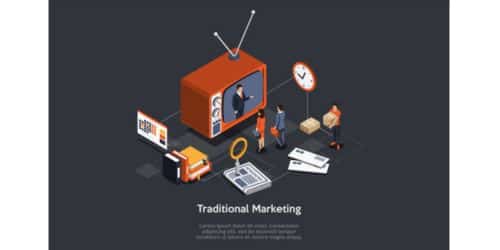Despite the rise of digital marketing, traditional marketing still holds its ground as a solid method for reaching target audiences. Businesses can incorporate a traditional marketing method to promote their products and, over time, get good results. If you are a business owner and you are considering which marketing strategy to adopt, this post will explore traditional marketing and its examples and highlight the key differences between digital, content and traditional marketing.
Traditional Marketing
Traditional marketing refers to any form of advertising that is not conducted online. It entails using offline channels to communicate with and interact with the target audience. Advertisements in newspapers and magazines, billboards, direct mail, phone calls, and classic forms of broadcast media such as radio and television are all traditional marketing channels.
Traditional Marketing Method
Traditional marketing methods refer to offline strategies and channels businesses use to reach their target audience and promote their products or services. These methods predate digital marketing and include a variety of tactics such as print advertising, direct mail, television and radio ads, billboards, trade shows, and face-to-face interactions. While digital and content marketing has become increasingly popular, traditional marketing still plays a role in reaching local audiences and creating brand awareness.
Examples of Traditional Marketing Methods
Examples of traditional marketing methods include:
- Print advertising: This includes placing ads in newspapers, magazines, coupon books, and other printed media. Print ads allow businesses to reach a wide audience and can be targeted to specific demographics or interests.
- Direct Mail: Direct mail involves sending promotional materials like brochures, postcards, and catalogs directly to potential customers’ mailboxes. This method allows for targeted marketing and can be personalized to increase engagement.
- Television and radio ads: Broadcasting through television and radio allows businesses to reach a large audience and create compelling commercials with visual presentations and demonstrations. Television ads are effective for showcasing products, while radio ads can be used to reach a local audience.
- Billboards: Billboards are large outdoor advertisements displayed in high-traffic areas. They can be effective in creating brand awareness and reaching a wide audience.
- Trade shows: Participating in trade shows and exhibitions allows businesses to showcase their products or services to a targeted audience. It provides an opportunity for face-to-face interactions and networking with potential customers and industry professionals.
- Face-to-Face interactions: Meeting potential customers through networking events, conferences, or sales calls can effectively build relationships and close sales. This method harnesses the power of human interaction and creates lasting impressions.
- Signage and flyers: Using signage, billboards, and flyers in strategic locations can be a cost-effective way to reach a local audience. With advancements in design tools, businesses can create visually appealing print materials that capture attention.
Why Choose Traditional Marketing for Your Business?
Traditional marketing has several advantages over digital marketing, which can benefit your business. Those advantages include:
- Familiarity: Traditional marketing methods are easy to understand and accept for older generations, who may need to be more familiar with navigating the internet or using digital platforms.
- High success rate: It has been tried over time and has a proven track record of success. Traditional marketing methods, such as radio ads, direct mail, and physical displays, provide convenience and visibility to customers needing to engage with digital platforms.
- Brand exposure: It offers a mass effect and impacts through mass media campaigns. TV ads, billboards, stadium displays, and other traditional advertising can surround potential customers with a brand’s message, products, and value proposition.
- DIY options: Many traditional marketing channels, such as direct mail, events, and personal contact, can be executed by the marketing team without external partners or agencies. This can result in cost savings and greater control over the marketing process.
- Targeting specific audiences: Traditional marketing methods, like direct mail, can deliver specific offers to specific people. While digital marketing is making strides in targeting capabilities, direct mail remains a strong method for reaching specific individuals with personalized offers.
Possible Drawbacks of Using Traditional Marketing for Your Business
The downside of using traditional marketing methods includes:
- Lack of immediacy: It needs to allow quick responses to marketplace changes. Creating and running print ads, magazine ads, or broadcast ads can take weeks or even months in advance. This lack of immediacy can be a limitation when adapting to rapidly changing consumer preferences and market conditions.
- More challenging to target audience: Traditional marketing methods, such as print and broadcast media, provide limited information about the audience that engages with the advertisements. Targeting specific individuals or tracking their engagement with the ads can be challenging with traditional marketing.
- Difficulty in measuring effectiveness: Traditional marketing can be harder to measure regarding return on investment (ROI). For example, it can be challenging to determine the actual readership of a newspaper or magazine ad or the number of viewers who saw a broadcast ad. This lack of measurability can make it difficult to assess the success of a traditional marketing campaign and adjust strategies accordingly.
- Limited customization: It often needs more ability to personalize and customize messages for individual customers. While specific market segments can be targeted, it is challenging to tailor advertisements to the preferences and interests of individual consumers.
- Cost: TV ads or direct mail campaigns can be expensive, especially for small businesses with limited budgets. Costs can include production expenses, advertising space, and distribution fees.
- Limited reach: It often has limitations in terms of reach. For example, print ads are limited to the publication’s circulation, and broadcast ads are limited to the audience of the particular channel or time slot.
- Declining audience: Traditional media outlets, such as TV and newspapers, are experiencing a decline in their audience as more people consume news and media through digital channels.
Digital Marketing vs. Traditional Marketing
Digital and traditional marketing are two different approaches to promoting products or services. Traditional marketing refers to using offline media, such as print ads, billboards, TV and radio commercials, and direct mail, to reach an audience. On the other hand, digital marketing utilizes online channels, such as the Internet, social media, mobile phones, and other digital devices, to market products or services.
Digital Marketing vs. Traditional Marketing: Differences
The differences between digital and traditional marketing lie in their target audience reach, cost and efficiency, interactivity and engagement, measurability and analytics, flexibility and real-time updates.
Digital vs Traditional Marketing: Audience Reach
Traditional marketing has a wider reach as it targets a broader audience through mass media channels like TV, radio, and newspapers. It can effectively reach older populations that need to be more digitally connected. Digital marketing, on the other hand, allows for more targeted and personalized marketing efforts, as it can reach specific demographics, interests, and behaviors. With digital marketing, businesses can target their target audience and deliver tailored messages.
Digital vs Traditional Marketing: Cost and Efficiency
Digital marketing is generally more cost-effective compared to traditional marketing. It’s platforms offer flexible budget options, allowing businesses to allocate their budgets more efficiently. Also, digital marketing campaigns can be easily tracked and measured, providing insights into the effectiveness of the marketing efforts. Traditional marketing, on the other hand, can be more expensive, especially for mediums like TV and print ads. Measuring traditional marketing campaigns’ exact impact and ROI can also be challenging.
Digital Marketing vs. Traditional Marketing: Interactivity and Engagement
Digital marketing allows for two-way communication between businesses and consumers. Customers can engage with brands through comments on social media posts, direct messages, online reviews, and chatbots. This level of interactivity and engagement can help businesses build stronger relationships with their customers. Traditional marketing, on the other hand, is more of a one-way communication channel. Consumers need more opportunities to interact with the brand directly.
Digital Marketing vs Traditional Marketing: Flexibility and Real-Time Updates
Digital marketing offers more flexibility and real-time updates compared to traditional marketing. With digital marketing, businesses can change their ad copy, budget, target audience, and other parameters even when the campaign is live. This allows for optimization and testing to improve the effectiveness of the marketing efforts. In contrast, traditional marketing materials like print ads or billboards cannot be easily edited once they are out. Any changes would require reprinting or redesigning the materials.
Digital Marketing vs Traditional Marketing: Measurability and Analytics
Digital marketing provides advanced analytics and tracking capabilities. Businesses can measure the performance of their campaigns in real-time, track conversions, analyze user behavior, and make data-driven decisions to optimize their marketing strategies. Traditional marketing, on the other hand, can take more work to measure accurately. It may rely on surveys, market research, or estimated reach and impact based on circulation or viewership data.
Content Marketing vs Traditional Marketing
Content and traditional marketing are two different approaches to promoting products and services. Traditional marketing includes methods such as TV commercials, radio ads, print ads, and brochures, which are forced into the view of a person. These ads can reach a large audience but require a large budget. On the other hand, content marketing, also known as inbound marketing, is a strategy in which various types of content are created and published online to attract audiences. Instead of being forced on audiences, the content sits there forever to attract audiences to it instead. Content marketing focuses on delivering information that is helpful to the target audience, creating trust with the reader. It is a long-term strategy that aims to nurture leads and guide them through the sales funnel.
Content Marketing vs Traditional Marketing: Differences
The differences between content marketing and traditional marketing lie in their purpose, conversational style, specificity, and driving force.
Content Marketing vs Traditional Marketing: Purpose
Traditional marketing is focused on directly advertising and selling products or services. It provides information about a business’s offerings, hoping to convince customers to purchase. On the other hand, content marketing provides value to the reader or viewer by delivering useful and relevant information. It aims to attract and engage the audience, building trust and loyalty over time.
Content Marketing vs Traditional Marketing: Conversational Style
Traditional advertising is a one-way communication where the company talks to consumers. There is no easy way for consumers to interact or ask questions. In contrast, content marketing, especially online, allows for two-way communication. Consumers can leave comments, provide feedback, and interact with brand representatives, creating a more involved and interactive experience.
Content Marketing vs Traditional Marketing: Specificity
Traditional advertising is often general and reaches a broad audience. Marketers may have limited control over who sees their ads. Content marketing, on the other hand, allows for precise targeting. Marketers can research their audience and create content specifically designed for the right people, increasing the chances of engagement and conversions.
Content Marketing vs Traditional Marketing: Driving Force
In traditional advertising, the business is the driving force behind the content. The marketing team decides what to share, when to share it, and where to share it. In content marketing, the public plays a role in deciding what content is worth sharing. Consumers can engage with and promote content at their own pace, giving them more control over its distribution.
What Is the Traditional Marketing Theory?
Traditional marketing theory is the cornerstone of marketing techniques, focusing on understanding consumer behavior, developing strategies, and effectively promoting goods or services. It includes the “Four Ps” (product, price, place, and promotion) and emphasizes mass marketing, which aims to reach many people through conventional advertising channels. Understanding consumer behavior is a primary focus, and firms must research consumer wants, needs, preferences, and purchasing patterns to develop successful marketing strategies. Market segmentation is crucial, as businesses can target specific market segments to appeal to various customer groups. Research in marketing is essential for assembling relevant data and gathering insights, enabling organizations to make informed decisions.
Conclusion
In conclusion, traditional marketing refers to any form of advertising that is not conducted online, using offline channels to reach and interact with the target audience. It includes methods such as print advertising, direct mail, television and radio ads, billboards, trade shows, and face-to-face interactions. Also, it still holds advantages such as familiarity, high success rate, brand exposure, DIY options, and targeting specific audiences. However, it also has drawbacks such as lack of immediacy, difficulty in targeting and measuring effectiveness, limited customization, cost, and limited reach.
Related Articles
- Digital Marketing for Small Business & How to Do It Rightly 2023
- PRINT MANAGEMENT: Definition, Service, Software & Solution
- INTELLECTUAL PROPERTY INFRINGEMENT: Meaning, Types, How to Avoid It, and Examples






